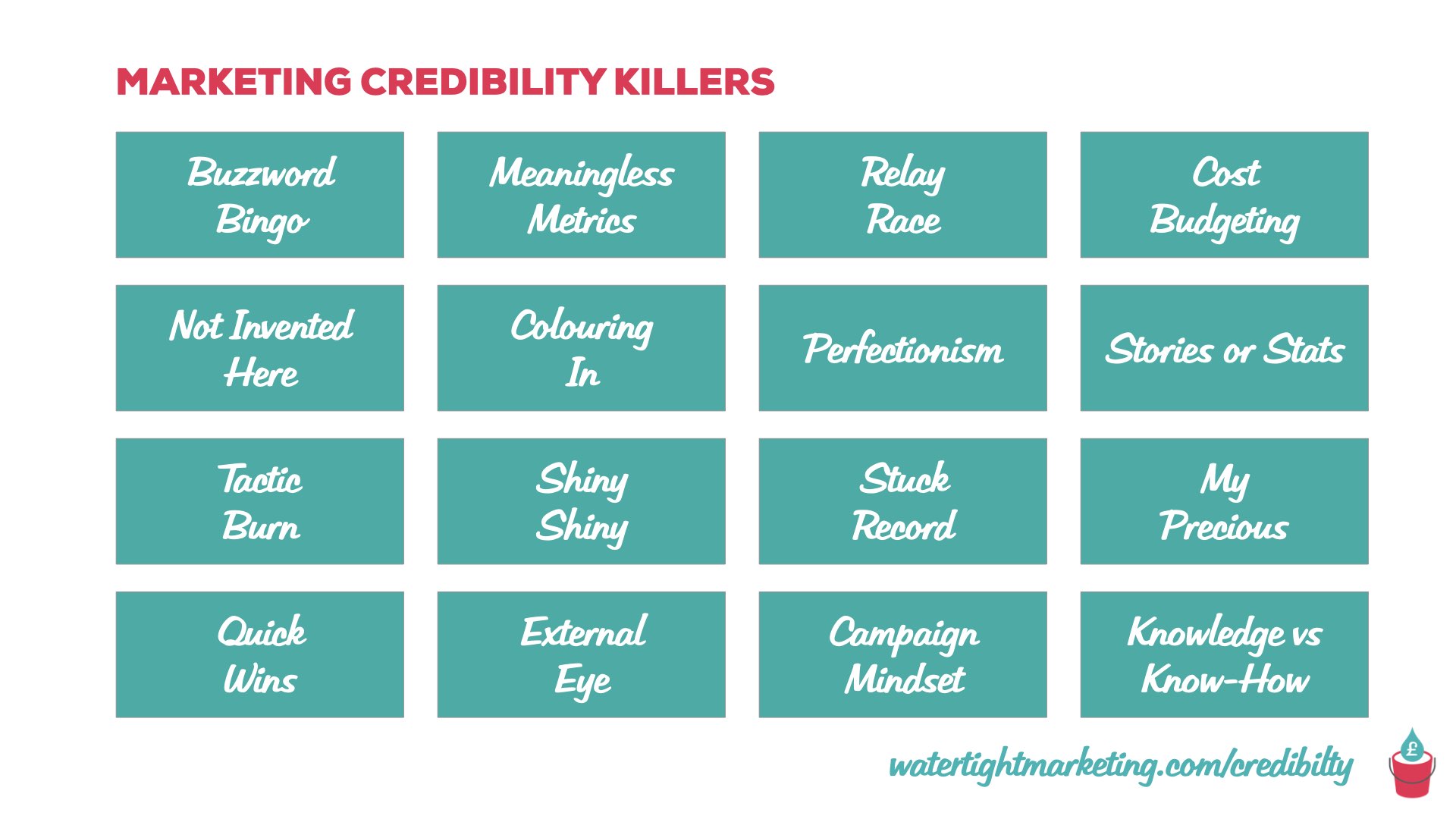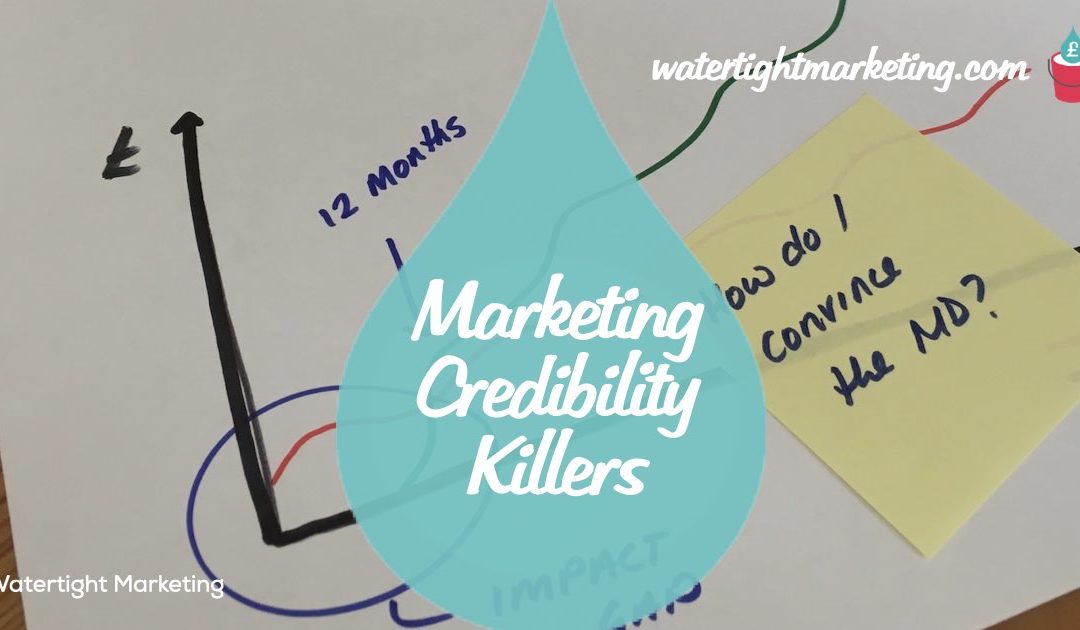Reading Time: 5 Minutes
It’s a common lament of client side marketers that their colleagues don’t see the strategic benefit of marketing. Cynicism seems to come from all sides. In this post, we look at ways that marketers themselves exacerbate the issue… and what to do about it. ~ Bryony Thomas, Author | Watertight Marketing
Listen to the session podcast here
56 -minute roundtable discussion on building your credibility within the business
Read the write up here
10 – minute read. The write up from the round table discussion on building your credibility within the business.
In our typical client, a £2-£20m turnover SME, the marketing ‘department’ is very often one person, maybe two. But, it’s very rare that marketing is a core discipline (at least, when we start out). It’s often grown from initially bringing in a junior to “tart up our materials” and “do a bit of social media.”
This can lead to layer upon layer of frustration. The business sees little bottom line benefit from marketing. And, the marketer perceives very little value placed on what they do. Even in businesses that have made the investment in an experienced and qualified marketing manager, these frustrations persist.
Here are 16 things we’ve seen time and time again, (and that sit within the marketer’s control), that can fuel frustration and actively undermine the strategic impact of marketing.

Buzzword Bingo
I remember when I was teaching the CIM Diploma a student said to me that one of their reasons for doing the qualification was so they could “sound like a marketer” – NOOOOO! That’s literally the last thing you want to sound like… you want to think like a marketer, but sound like whomever it is you’re talking to at that time. Talking to your sales director; talk about sales results. Talking to your HR director; talk about staff retention and satisfaction. Talking to your finance director; talk about the P&L. Using faddy marketing jargon, that needs explaining to anyone outside the function, is a very fast way to get eyes to glaze over.
- Tip: Consider your colleagues as you would an external audience and find the language that works for them.
Meaningless Metrics
This one drives me a bit nuts. Marketers seem obsessed with Volume metrics. How many followers they have, the open rates on emails, the visitors to websites, etc. Volumes without context are meaningless.
They need to be put in context of four things, 1) Where it is within a decision journey, 2) Its conversion ratio to the next step in that journey, 3) The likely timeline from that interaction to bottom line results, 4) The likely financial outcome that Volume of X will later deliver.
- Tip: Read Chapter 10 of Watertight Marketing, here’s a little summary for you.
Relay Race
When a customer journey (or any other decision journey for that matter) is presented as a relay race, where marketing hands leads to sales, and sales hands customers to service, you can be almost certain that money is being left on the table! Marketing, Sales and Service all have things to bring to every single step of a sale.
- Tip: Map the contribution of each discipline to each step, here’s a starter on this for you.
Cost Budgeting
When you put together a marketing budget, how do you determine how much to spend or what on? Most marketing budgets I’ve reviewed are simply a shopping list of things the marketer wants to do with their associated price tags. By attaching your budget request to a percentage of target revenue (like index linked pricing) and using Visual Budgeting (from Chapter 9) — the strategic intent of your budget request is embedded in it.
- Tip: Read Chapter 9 of Watertight Marketing, here’s a little summary of the Visual Budgeting technique.
Not Invented Here
We particularly see this in marketers who’ve just landed their first senior role. There’s a sense that they have to have come up with everything themselves, from a blank sheet of paper, to prove themselves worthy. It’s almost as if they’re in competition with every other marketing thinker out there. Those that embrace the world of wisdom that already exists go much further than those that attempt to reinvent the wheel.
- Tip: Be proud to learn and apply best-in-class thinking tools and models!
Colouring In
Many marketers can get trapped in being the colouring-in department, where things come to you last to “make it look pretty” – as if the marketing of something is an afterthought or add-on to an already completed piece of work. We would always advise an in-house marketing team to work with professional external designers on these sorts of things, and insist that a marketing brief is a pre-requisite of having any such work done.
- Tip: Create a briefing document that gets people to outline the requirement, rather than simply request a specific deliverable. (See: how to write a marketing brief)
Perfectionism
I describe myself as a ‘recovering perfectionist’ – it’s something I work on almost daily. If you wait until things are ‘perfect’ before you release them, you may never do so. Momentum is gained by establishing the minimum acceptable standard (which may be lower than your internal bar) and allowing things to go when it meets that. Daniel Priestley is known for saying “prolific beats perfect” and I am minded to agree with him. Our phase for this is to set the first bar as “functional and not too embarrassing.”
- Tip: Embrace that the only way to achieve your best work is to put it into the world imperfectly and to iterate from there. (Get the poster: Functional, and not too embarrassing)
Stories or Stats
We often find that marketers express themselves either all in story and metaphor, or all in stats. If you take either position all of the time, you will definitely wind people up some of the time. Neither is right. And, neither stands alone. You will need both!
- Tip: Use The Logic Sandwich from Chapter 3 to shape your internal and external communication.
Shiny Shiny
Is there any discipline faddier than marketing? Did you dive into ClubHouse? Have you tinkered with TikTok? Marketers are often magpies, and will often tell me that one of the things they love about their role is the novelty and keeping up with trends. I’m all for that, but in moderation. I’d advise no more than 10% of time and/or money be expended on wholly novel activities. We’ve seen much better results from smart followers than first movers (Anyone remember Friends Reunited?).
- Tip: When a new technique or channel crops up, run it through the Watertight frameworks to assess its potential role in your marketing, and track it for a while to ensure you’re not the one paying to teach others.
Tactic Burn
Tactic Burn is related to, but distinct from, the marketing magpie. This is where test and learn becomes trash and burn. You ‘test’ something and when it ‘doesn’t work’ you forever cross it off your list. We often find that things that ‘didn’t work’ are in fact perfectly good — but failed by not being set in context of a full path to purchase, or were not allowed to run for long enough to take effect.
- Tip: Always test new techniques or tools within a full path to purchase and a realistic time horizon. (See: What is tactic burn?)
Stuck Record
This is the opposite problem to the magpie. Here we see a marketer that has pet techniques and sticks rigidly to “the way things are done around here.” I’ve seen this a lot with B2B marketers who push back on some of our approaches saying, for example, that “emotion doesn’t work in a business context.” or some other such absolutisms.
- Tip: If you want to achieve different or better results, you will need to try different or better things!
My Precious
Some marketers we encounter get very precious about marketing being their dominion. Almost to the extent that there’s a boundary on who is permitted to have an idea. There’s a fine line here. We completely agree that marketing should be fully respected as an expertise, but if we want the enthusiastic support of our peers we need to help them to understand what we do and invite their involvement.
- Tip: Run a series of ‘what is marketing’ lunch & learn sessions or team days (better still, have us facilitate these with you!), and create a system for people sharing their ideas with you.
Quick Wins
Who doesn’t love a quick win?! It’s very gratifying to do something and see an immediate positive benefit. Where this becomes a credibility killer is when it all you’re focused on. Quick wins should be a bonus, not the bread and butter of what you do. To be seen strategically, you’ll need to predominantly have a long term focus, with enough quick wins to keep life fun.
- Tip: Talk people through the Yo-Yo Marketing concept and agree on both long-term and short term objectives.
External Eye
Many people will say that it’s the marketer’s job to be the customer champion, and to be market scanning. Again, I don’t disagree — but this can undermine your credibility if you’re unable to balance this with an internal eye too. It can be useful to gain insight and ideas from outside your business, but you’d be amazed how much exists internally if you ask. The added benefit of doing this is that you gain their goodwill and engagement too.
- Tip: Remember to look inside the business for insight and ideas, and don’t forget that keeping them loyal to the vision is as important as keeping customer loyal to your products.
Campaign Mindset
Many marketing teams simply go from campaign to campaign. A massive amount of energy goes into delivering a big burst of activity. Then, when it’s done, you recoup and re-plan for the next one. Just as quick-wins should be a bonus on top of long term objectives, campaigns should be the cherry on top of a baseline of activity. If you market yourself in this up / down rhythm, you don’t gain the compound value or cumulative momentum of marketing that’s like a consistent heart beat.
- Tip: Get a Baseline Activity Plan in place as a minimum, and layer campaigns on top of that.
Knowledge vs Know-How
I’ve lost count of the number of MDs that have shared with me that their highly qualified marketing person doesn’t seem to know what to do. Marketing qualifications are great, I have notched up a few of them myself. But, translating what’s taught (often with the unreachable likes of Apple as a case study) in a small business and on a modest budget can be a real challenge.
- Tip: If you have a qualified, but inexperienced, marketer — get them a seasoned coach to help them make the transition (yes, we offer this service!)
If you want to talk to us about stepping up the credibility of marketing within your organisation, please take 10 minutes to do the Watertight Marketing Test — there’s a link with the report you’ll be sent to a 45-minute review call where we can unpack your results and give you some advice on positioning yourself, and marketing, more strategically.

Bryony Thomas
Author & Founder, Watertight Marketing
Bryony Thomas is the creator of the multi-award winning Watertight Marketing methodology, captured in her best-selling book of the same name. She is one of the UK's foremost marketing thinkers, featured by the likes of Forbes, The Guardian, Business Insider and many more, and in-demand speaker for business conferences, in-house sales days and high-level Board strategy days.



Good list Bryony
A great read – see a lot of tactic burn and meaningless metrics in professional firm marketing. Thanks for sharing.